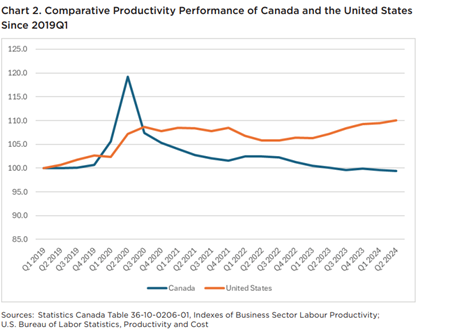Highlights of Canada's Productivity Summit in Calgary
 Peter Josty is Executive Director of The Centre for Innovation Studies in Canada.
Peter Josty is Executive Director of The Centre for Innovation Studies in Canada.
Canada's Productivity Summit in Calgary attracted more than 700 participants and 70 speakers. The Summit, October 16 and 17, was organized by the School of Public Policy at the University of Calgary and sponsored by the Alberta government. Here are the highlights.
Why productivity is important
There was a good deal of discussion about why productivity was important. The main benefits of improved productivity are that:
- It lowers inflation.
- It boosts economic growth.
- It improves living standards and wages and salaries.
- It boosts tax revenues.
More broadly, Canada faces a number of very expensive challenges in the next few decades and will need resources to deal with them. These resources will need to be provided by better productivity.
These challenges include an aging population (by 2050, 25 percent of Canada’s population will be over 65) and climate change.
It was noted that the word “productivity” has a negative connotation for many people as it seems to imply working harder, not smarter.
Comparisons in productivity
Productivity varies a lot across Canada, with Alberta being the most productive province. A major reason for this is the industry composition in each province. Some industries are much more productive than others.
The main reason that Alberta is the most productive province is because the province has as large proportion of the oil and gas sector, which is extremely productive.
When it comes to productivity, Canada is falling behind its G7 and G20 peers. Canada is projected to have the lowest growth in the OECD from now to 2060.
Most sectors of the Canadian economy have seen productivity decline in recent years. Two exceptions are the agriculture and forestry sectors, where productivity has improved significantly.
The graph below, from the Productivity Summit pre-read document, compares the output per hour worked in the U.S. and Canada since 2019.

Causes of the problem
It was recognized that the productivity problem was caused in Canada and not imposed from elsewhere. It is a longstanding problem that has developed over many years, although it has become more acute in recent years.
There are a multitude of causes and contributing factors, many of them interrelated, including:
- Lack of productive investment. It was noted that investment in housing (which is not regarded as investment that increases productivity) is now larger than investment in businesses.
- The large proportion of SMEs in Canada. Small companies are much less productive than large companies, so the large proportion of SMEs in Canada (compared with the U.S.) decreases productivity.
- Interprovincial trade barriers. It was estimated that removing these barriers would increase Canada’s GDP per capita by about four to five percent.
- Low spending on research and development. Canada spends about half the OECD average on R&D.
- Low business spending on machinery and equipment.
- Lack of competition in many sectors of the Canadian economy. This removes the incentive to innovate. The supply management program for dairy was mentioned as keeping that sector uncompetitive internationally and raising prices in Canada.
- Large government spending, particularly during COVID. This crowds out private sector investment and raises inflation, so higher interest rates are needed to control inflation and that reduces business capital spending.
- High level of regulation and regulatory uncertainty. Large capital projects need to be sure that regulations are going to be stable for the project duration. In the absence of regulatory certainty, projects get postponed or cancelled. Most foreign investment in the oil and gas sector has left Canada for this reason.
- Low adoption of information technology by Canadian businesses. One example, provided by a Canadian IT company, is that it took a Canadian company 18 months on average to adopt AI. In the U.S., it took four months, and in the United Arab Emirates, one week.
- Tax competitiveness. There was some ambiguity about this. It was stated that Canada was more or less competitive on the corporate tax side but uncompetitive on personal taxes.
Potential solutions to the problem
There was no shortage of ideas on how to improve productivity in Canada. However, it was stressed repeatedly that this is a very difficult problem that involves difficult political tradeoffs and that to solve it will require building a robust consensus (that doesn’t currently exist) on the need to improve productivity.
It is critical to build a partnership between government and business. An adversarial approach will not work. If a consensus cannot be achieved, an incremental approach might work.
A parallel situation was the need, in the 1980s, to reduce a large government deficit that became a crisis. A consensus emerged, after significant leadership from the government, to undertake deep budget cuts. This was accepted by the public, and the government was re-elected.
Take interprovincial trade barriers, for example. These have been recognized for many years, but the political will to resolve them has not emerged.
Here are some of the ideas presented at the Summit to improve productivity:
- Improve the competitiveness of the Canadian economy. There was discussion of the many sectors of the economy that are oligopolies and how that reduces the incentive to innovate and leads to complacency.
- Make regulations and policies faster and clearer. The need to de-politicize regulations was discussed, as well as removing regulatory uncertainty by, for example, setting regulations for a period of five years. One suggestion was to adopt a “consumer first” approach to new regulations and policies, to make sure regulations benefit consumers rather than the companies.
- Review all the industry subsidies to see which ones actually work. The largest program – the Scientific Research and Experimental Development tax credit – is intended to increase business R&D in Canada, but clearly has not worked, as business R&D has declined. Poorly designed subsidies can divert jobs from more efficient sectors. The many programs supporting innovation have also clearly not worked, as Canada’s innovation has declined.
- Return to a merit-based immigration system. It was noted that temporary foreign workers do not improve productivity, as they mostly work in low productivity sectors, like hospitality and tourism, and they depress wages and incentivize companies to employ people rather than investing in capital improvements.
- The provinces could work together to remove interprovincial barriers to trade.
- Remove barriers to foreign capital coming to Canada. It was noted that Canada does not produce enough savings to meet its own requirements, so foreign capital is essential to promote future growth.
It was also noted that the imposition of large tariffs on exports to the U.S. would devastate the Canadian economy. Such tariffs are advocated by U.S. presidential candidate Donald Trump.
Conclusion
Canada’s poor productivity is a serious problem. If it cannot be improved, Canada will continue its relative decline compared with other OECD countries.
The first step in finding a solution is to establish a consensus among government, business and the public that Canada's productivity performance is a problem worth tackling. However, the difficulties of doing this should not be underestimated.
R$
| Organizations: | |
| People: | |
| Topics: |
Events For Leaders in
Science, Tech, Innovation, and Policy
Discuss and learn from those in the know at our virtual and in-person events.
See Upcoming Events
You have 1 free article remaining.
Don't miss out - start your free trial today.
Start your FREE trial Already a member? Log in
By using this website, you agree to our use of cookies. We use cookies to provide you with a great experience and to help our website run effectively in accordance with our Privacy Policy and Terms of Service.





